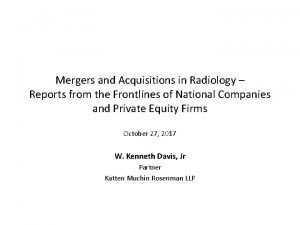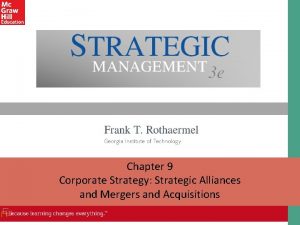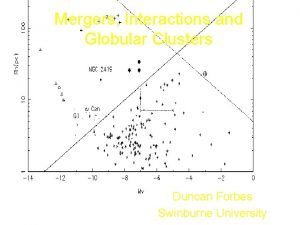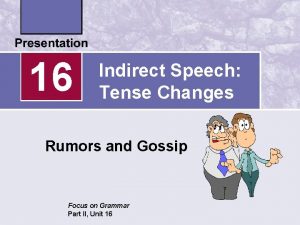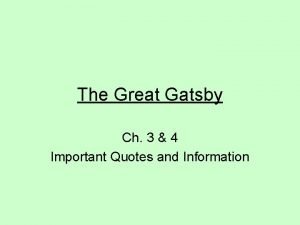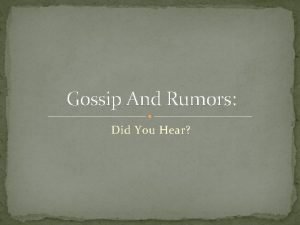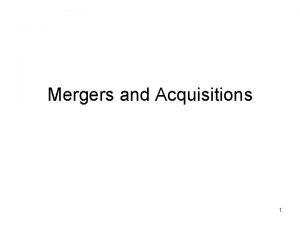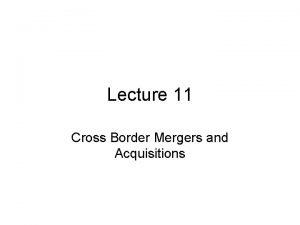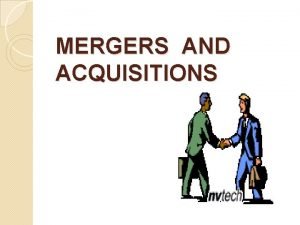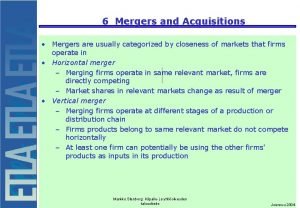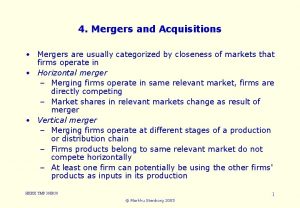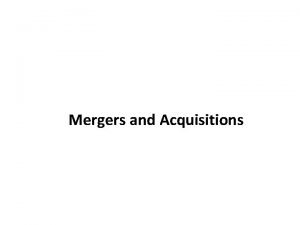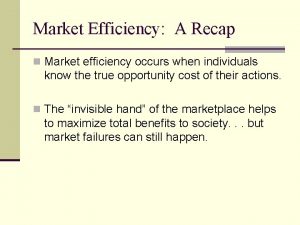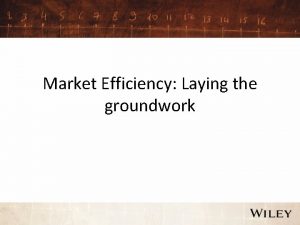Rumors of Mergers and Acquisitions Market Efficiency and
















- Slides: 16

Rumors of Mergers and Acquisitions: Market Efficiency and Markup Pricing Hsin-I Chou, La Trobe University Gloria Y. Tian, UNSW Xiangkang Yin, La Trobe University

Sources of M&A Rumors Public Speculation Hypothesis Information Leakage Hypothesis To Convey True Information To Manipulate the Market Financial (M&A) Rumor o “Winners” (true): o “Losers” (false): Rumor-Announced Group Rumor-Only Group 2010 NTU international conference

Key issues • Can false takeover rumors be picked up? • Does the market respond to takeover rumors efficiently? • Can investors trade on rumors to make a profit? • Do bidders markup price? 2010 NTU international conference

Stylized timeline of M&A events 2010 NTU international conference

First Impression of the Sample … … Successful (60 firms) Takeover Announcement (72 firms) Rumored Targets (517 firms*) Collapsed (12 firms) No Takeover (187 firms) 2010 NTU international conference

Abnormal return • Regress the following market model for each target firm to estimate αi and βi • They are then used to estimate the abnormal return. • Unless otherwise indicated, the event day is the day of the first rumor publication. • We consider both 42 -day and 21 -day pre-runup periods. • The estimation window used to estimate coefficients in the regression is either t = -242 to -43 or -221 to -22. 2010 NTU international conference

Cumulative abnormal return • The cumulative abnormal return (CAR) of firm i between date t 1 and t 2 is given by where εit is the difference between actual return and the return based on estimated αi and βi o For robustness, we also re-calculated CAR using 3 factor model. 2010 NTU international conference

Runups and markup • The pre-runup of target i is calculated by its CAR between day -42 (or -21) to day -1, i. e. • The post-runup is the CAR in the post-runup period, where T is the date of the first bid announcement. • The markup is the CAR from the day of the first bid through delisting or 126 trading days, whichever comes first, 2010 NTU international conference

Main findings • At the time of rumor publication (event), investors can statistically distinguish the two types of rumors (winners vs. losers), based on publicly available historical stock price information. • On the rumor day and the day after, the abnormal returns of target firms in the rumor-announced group are statistically indifferent from those of target firms in the rumor-only group. 2010 NTU international conference

Main findings • Investors can trade on rumors to reap abnormal returns. – Long winner stocks, or all rumored stocks – Annualized excess return up to 100% or more 2010 NTU international conference

Are the findings new? • Pound and Zeckhauser (1990) argue that the “market is efficient at responding to published takeover rumor” because trading on rumors cannot make excess returns. – Their trading strategy is buying at the closing price on the rumor day and selling at the closing price on the first formal bid day or one calendar year after the rumor day. • This contradicts our findings. – A key difference between their strategy and ours is that they do not select “winners” from “losers”. – Even we follow their strategy, it still yields an estimated excess return between 42% and 55%. 2010 NTU international conference

Main findings • Rumors have substantial impact on target stock prices. – Substantial rise of CAR around rumor day – Pre-runup dominates post-runup. • Both markup pricing and substitution hypotheses can be rejected. – a 1% increase in the pre-runup (post-runup) of a target’s CAR results in about a 1. 6% (1. 2%) increase in takeover premium. 2010 NTU international conference

Markup Pricing and Rumors • Markup Pricing: a one-dollar increase in the target’s stock price in the runup period should on average result in a one-dollar rise in the takeover premium. – The efficient markets view • Runup reflects new information unknown to the bidder and highlights some attractive properties of the target firm the bidder is willing to pay a bit more premium • Substitution Effect: increase in runup price should be independent of the takeover premium, because there is no new information but rather anticipation. • If the takeover rumor provides no new information, then runup should have insignificant impact on premium

Are the findings new? • Schwert (1996) finds that a 1% increase in the runup of the target’s CAR leads to approximately a 1% rise in the total offer premium. • Betton, Eckbo and Thorburn (2008) find a 1% rise in runup yields an average increase of 0. 8% in the takeover premium implied in the initial offer. • We find a much stronger price impact of runups. – In particular, pre-runups are bigger and have a larger impact on takeover premium than post-runups 2010 NTU international conference

Summary of Findings • Can false takeover rumors be picked up? – YES (CARs before rumor publication) • Does the market respond to takeover rumors efficiently? – NO (indifferent market responses) • Can investors trade on rumors to make a profit? – Yes (long winners or all rumored targets) • Do bidders markup price? – YES & NO (a bit too strong; overreaction? )

Thanks for your comments & suggestions 2010 NTU international conference
 Mergers and acquisitions rumors
Mergers and acquisitions rumors Radiology mergers and acquisitions
Radiology mergers and acquisitions Hr issues in mergers and acquisitions
Hr issues in mergers and acquisitions Franchise mergers & acquisitions advisors
Franchise mergers & acquisitions advisors Divestiture in corporate restructuring
Divestiture in corporate restructuring Mergers in strategic management
Mergers in strategic management Equity strategic alliance example
Equity strategic alliance example What is mergers and acquisitions
What is mergers and acquisitions Forbes mergers & acquisitions
Forbes mergers & acquisitions Examples of rumors and gossip
Examples of rumors and gossip Great gatsby chapter 3 quotes
Great gatsby chapter 3 quotes Believing rumors
Believing rumors Productive inefficiency and allocative inefficiency
Productive inefficiency and allocative inefficiency Productively efficient vs allocatively efficient
Productively efficient vs allocatively efficient Allocative efficiency vs productive efficiency
Allocative efficiency vs productive efficiency Market segmentation lesson
Market segmentation lesson Hypothetical market structure
Hypothetical market structure

